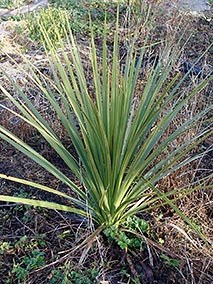Restoring our Southland’s natural habitats is enjoyable and very rewarding. Forest remnants respond well to careful management and the benefits of planting can be seen in a relatively short space of time. However, it’s important we follow nature’s path from bare ground to forest. Find out more about habitat restoration, the process of ‘succession’ and what to plant at your place. Refer to a talk by Brian Rance “Right Plant, Right Place”.
Planting plan
Before you begin your planting project, you need to have a sound planting plan. You need to know what to plant and where to plant if you want to avoid wasting time, effort and money. To do this you need to know a bit about how forests work and the process of succession.
How forests work
 Cabbage tree.We tend to think of forests as being static, unchanging ecosystems. However, many of our forest remnants are undergoing a phase of re-establishment and repair. Many are in a transitional phase containing fast-growing colonising species and emerging slow-growing canopy species. Find out more about how forests work.
Cabbage tree.We tend to think of forests as being static, unchanging ecosystems. However, many of our forest remnants are undergoing a phase of re-establishment and repair. Many are in a transitional phase containing fast-growing colonising species and emerging slow-growing canopy species. Find out more about how forests work.
The process of re-colonising a bare patch of land is called ‘succession’. It takes many years for the process of succession to transform an area from bare land to mature forest. During the succession process each group of plants makes the site suitable for the next group of plants, but no longer suitable for themselves. These plants are called ‘colonising’ or ‘nursery’ plants. They are eventually replaced until mature canopy trees establish.
Colonising or nursery species
When we undertake a restoration project, we are trying to replicate the succession process that occurs in nature. When planting bare areas of land or exposed forest edges we need to plant species that would naturally colonise those areas. We need to focus on establishing the colonizing or ‘nursery’ species before mature forest species can take hold.
See how long it takes for a forest to establish in the diagram (by Lloyd Esler) below:
 Forest establishment over time (image by Lloyd Esler).
Forest establishment over time (image by Lloyd Esler).
What to plant
Restoration projects in Southland cover a variety of habitats. We’ve put together planting lists for different habitat types in Southland:
Find out more about each habitat type, what grows in each and the plants we suggest you start with.
Find out more
Find out more about Southland’s habitats in the following booklets:
- Forest Remnants of the Southland Plains – A Guide to Enhancing Forest Remnants
- Otatara–Sandy Point Bushcare – A Guide to Enhancing your Bush
- Wetlands of Southland – A Guide for Maintaining and Enhancing the Values of our Wetland Areas
- Coastcare – Caring for Southland’s coastal plant communities.
Booklets are available from the Invercargill City Council.
